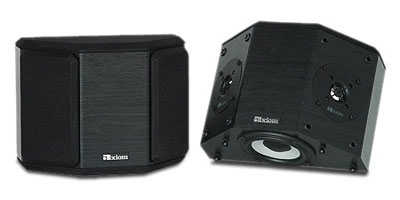Axiom Epic 80/500 Home Theater Speaker System Page 2

The Short Form |
| Price $3,332 (as tested, w/5% discount) / axiomaudio.com / 866-244-8796 |
Snapshot |
| Axiom's impressive system makes buying speakers off the Web a sure bet. |
Plus |
| •Clean, neutral sound on music •Wide dynamics, with low, powerful bass •Sleek, stately looks |
Minus |
| •Some drop-off in dialogue crispness at off-center seats •M80 towers need careful amp selection |
Key Features |
| Millennia M80 v2 ($1,330/pair) •(2) 1-in titanium tweeters; (2) 5.25-in and (2) 6.5-in aluminum woofers; 39.5 in high; 56.8 lb VP150 v2 ($408) •(2) 1-in titanium tweeters; (3) 5.25-in aluminum woofers; 7.5 in high; 21.8 lb QS8 v2 ($540/pair) •(2) 1-in titanium tweeters; (2) 5.25-in aluminum woofers; 8.3 in high; 13.5 lb EP500 v2 ($1,230) •12-in aluminum driver; 500-watt amplifier; 19.5 x 15 x 19.5 in; 72.5 lb |
Test Bench |
| The M80's response has a 7-dB floor-bounce notch at 400 Hz and falls by 1 dB/octave above 200 Hz. The VP150 center showed significant off-axis lobing as soon as the mike was moved off center; you can hear the sound change as you walk about the speaker. The QS8's multiple driver facings offer interesting interference patterns at all listening angles to encourage good envelopment. The EP500 sub has excellent bandwidth uniformity, delivering 104-plus dB at any frequency above 25 Hz. - Tom Nousaine Full Lab Results |
With two tweeters flanking a trio of center-mounted 5.25-inch woofers, the VP150 is likewise one of the more curious center-channel speakers I've come across. Designer Ian Colquhoun says Axiom settled on this arrangement after determining its superior off-axis performance through rounds of measurements and double-blind listening.
The QS8 surround speaker is yet another unique design. One-inch tweeters mounted on either side of its angled baffle fire off the highs, while 5.25-inch woofers on the speaker's top and bottom handle bass. Although the QS8 looks like a typical dipole, its dual, opposed driver sets actually operate in-phase (bipole): In Axiom's worldview, THX-style dipolar designs are a no-no.
Rounding out the system's low end is the EP500 v2 subwoofer. A 500-watt amp drives the 12-inch woofer on the front of this hefty vented box; a DSP chip inside is said to allow the sub to hit frequencies below 20 Hz in an average listening room without distortion. Along with variable crossover and phase, you get high-level speaker and pro-style balanced line inputs and outputs. A trim dial offers three presets: Flat, Full (increases output above 33 Hz), and Half (partially increases output above 33 Hz).
Setup The M80 towers are rated at 4 ohms, which means you'll need an audio receiver or amplifier with enough juice to drive low-impedance loads comfortably. With 200 watts x 5 channels hooked up to the Epic 80 system, I had plenty of fuel. I nudged the M80s a few feet out from either side of a 50-inch plasma TV, while the VP150 center channel sat on a shelf in my TV stand. After hoisting the sub into the room's front-right corner and listening to some reference bass tracks, I set the trim dial to Flat and chose a 60-Hz subwoofer crossover on my processor for the M80 towers and 80 Hz for both the center and surrounds.
The bottom-firing woofers on the QS8 surround speakers limit you to two installation options: wall-mounting using supplied brackets or Axiom's FMS QS stands ($286/pair). I really liked the Axiom stands. Not only do they have an open bottom plate to let sound escape from the bottom woofer, they're extremely sturdy - and at 38 inches high, they're tall enough to hoist the speakers above ear level when you're sitting on the couch.
- Log in or register to post comments




















































